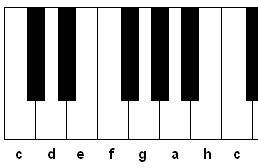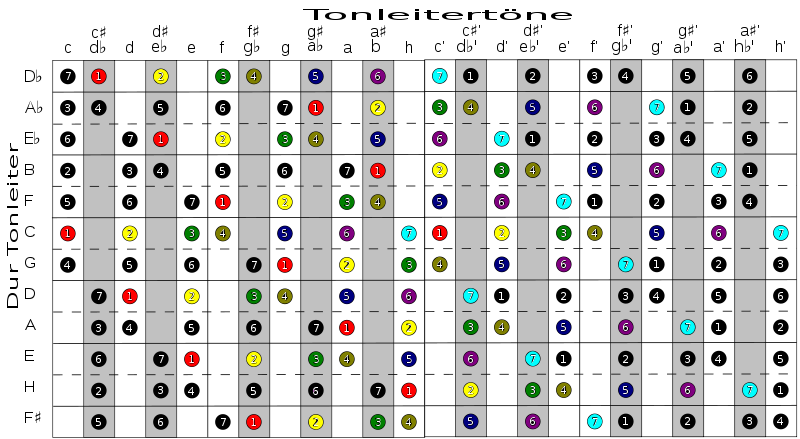Major scale
![]()
This article is about the tonal gender in major music. For other uses of the term, see Major (disambiguation).
Major (from Latin durus 'hard'; French mode majeur, English major, Italian modo maggiore, Spanish modo mayor) refers to a tonal scale in music. This can refer to a key, a scale or a chord.
In the course of the 18th century, major and minor replaced the terms modus major and modus minor (cantus durus and cantus mollis) for the tonal families of the church keys. Since then we have also spoken of the major-minor tonal system, or major-minor system for short. Major, minor and the church keys form the classical diatonic scales.
Major
Minor
A characteristic of the major character is the interval of a major third between the root and the third of the tonal material under consideration. The major third above the root is also called the major third.
The auditory impression of major is often described as "bright, clear" (Latin durus = "hard"), whereas minor is often described as "dark, soft" (Latin mollis = "mellow"). These characterizations should be used with caution. In particular, more far-reaching associations such as equating major with happy or minor with sad may be true, but they must not be generalized under any circumstances, because the overall musical impression can depend on a large number of other components. For example, melodic-harmonic progressions and figures, tempo, instrumentation, dynamic parameters, but also text (if present) play a decisive role. For example, Mozart's Rondo alla Turca or Beethoven's piano piece Für Elise are hardly perceived as "sad", although both compositions are in minor keys. Herbert Grönemeyer's song Der Weg, on the other hand, is considered a very sad composition, even though the piece is in the major key.
For the spelling of key names, see the Spellings section in the Keys article.
Etymology
The terms major and minor go back to the medieval hexachord theory, which distinguished between the hexachordum molle and the hexachordum durum, among other things.
In the case of the hexachordum durum, starting from the note G, a higher variant of the note B was needed, the B durum (our present-day B) as the third degree, while in the case of the hexachordum molle, starting from the note F, this higher note had to be avoided as the fourth degree (tritone) and the lower B molle was used instead.
To distinguish between the two, a small letter b with a round belly (b rotundum) was written in front of the lower B note, and a letter b with a square belly (b quadratum) in front of the higher B note, from which an H later developed. The present form of the transposition signs (a ♭ for the lower tone, a ♯ for the higher) also goes back to this. The Italian terms "bemolle" for the ♭ accidental and "bequadro" for the ♮ resolution sign also correspond to this.
The association of the tonal families with characteristics such as "hard" (= major) and "soft" (= minor) came much later with the disappearance of the church keys and the manifestation of the major-minor system, but has become entrenched in musical theory and is still held even in etymological dictionaries.
Major scale


Considered as a sequence of whole and semitone steps, the major scale has the following structure: 1-1-½-1-1-1-½ (or thought of as two tetrachords: 1-1-½ 1-1-½). Hereby it corresponds in its interval sequence to the Ionic mode. Since the 16th century, it has been the most widely used scale in Western music, even before the minor scale. For the Western ear it is the most familiar scale. Each of the twelve major scales is named after its first note. For example, the root notes C, D, E, F, G, A, B, C make up the C major scale.
Characteristic of the major scale are the semitone steps between the third and fourth and the seventh and eighth notes. The remaining intervals are whole-note steps. The seventh tone has the function of a leading tone.
On the keyboard of a piano, the white keys, beginning with C, produce a C major scale:
Audio example: ![]()
Table showing all major scales
Each field in the table corresponds to a degree of the chromatic scale. Keys with up to six (in exceptional cases seven) accidentals are in common use, i.e. 13 (or 15): the twelve scales shown in the table plus - with enharmonic reinterpretation of D flat - C sharp major. Keys with more accidentals are theoretically possible, but for reasons of readability they are not in use.
The major scales are represented within an octave in such a way that equal notes correspond to equal colors. Repetitions of the scale steps outside the octave in question are shown in black.

See also: Circle of fifths
Questions and Answers
Q: What is the major scale?
A: The major scale, also known as the Ionian scale, is one of the diatonic scales in music theory. It consists of seven separate notes plus an eighth note which is the same as the first note but an octave higher.
Q: How many notes are in a major scale?
A: A major scale has eight notes.
Q: What are the syllables used to represent each note in a major scale?
A: The syllables used to represent each note in a major scale are "Do, Re, Mi, Fa, Sol, La, Ti/Si, Do".
Q: What is the simplest major scale to write or play on a piano?
A: The simplest major scale to write or play on a piano is C Major since it does not require any sharps or flats and only uses white keys on the keyboard.
Q: How do you identify C Major on a piano keyboard?
A: C Major can be identified by playing all of the white keys starting from C and ending with C an octave higher.
Q: Is there any other way to identify C Major on a piano keyboard?
A: Yes - you can also look for two black keys followed by three black keys followed by two black keys - this will indicate that you have reached C Major.
Search within the encyclopedia